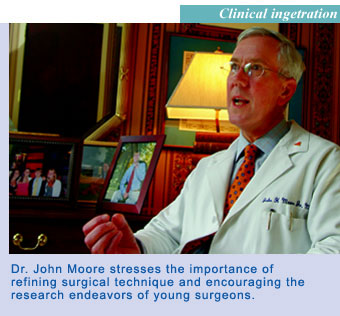
Recommended Citation
(2007)
"Trends in Plastic and Reconstructive Surgery,"
Jefferson Surgical Solutions: Vol. 1:
Iss.
2, Article 3.
Available at:
https://jdc.jefferson.edu/jss/vol1/iss2/3
Included in
As a teaching hospital, Jefferson benefits from being on the cutting edge of the latest techniques and technologies, including in the area of plastic and reconstructive surgery. Clinical Professor, John H. Moore Jr., MD, explains that part of the Jefferson philosophy is to encourage research among the residents, as surgeons move toward increasingly effective techniques that draw upon the body’s own tissues.

"With breast implants, for example, we were doing a TRAM-flap procedure, using tissue from the abdominal wall," Dr. Moore explains, "Now we have switched to using a latissimus dorsi flap (from the back), which seems to be even safer with fewer complications and without sacrificing the final result." Jefferson residents and college students are now compiling data from more than 700 patients as part of a 10-year study by the Department of Surgery evaluating the safety of this newer procedure.
The use of stem cells is another trend that has begun to show considerable promise, as the cells can be grown into bone, cartilage and fat in any desired shape. In breast augmentation, natural tissues do not cause the local scarring that can be associated with saline and silicone implants, although this use is currently experimental. For reconstructive surgery, stem cell tissue maintains its shape and size more effectively than conventional soft tissue implants. In 2003, former Jefferson resident Stephanie Houser Caterson, MD, won the American Society for Aesthetic Plastic Surgery's Anastasi Award for her work on stem cells. She and her husband, E. J. Caterson MD, PhD, also a Jefferson alumnus, conducted research on the ability to propagate stem cells into soft tissues such as bone, cartilage and muscle. Both are now surgical fellows at Harvard.
"We are training the next generation of surgeons to be even better."
Further research in this area continues at Jefferson under the direction of Dr. Moore's young colleague Gary Tuma, MD. "We hope to design a method to develop tissue-engineered fat-derived stem cells for soft tissue augmentation," says Dr. Tuma. While more research is needed, he hopes for funding that will allow him to open a tissue engineering lab at Jefferson in early 2007. Dr. Moore points out the benefits of the diverse research interests of Jefferson's Plastic Surgery faculty. "We are training the next generation of surgeons to be even better," he says, "and are always striving for a new standard of excellence."

